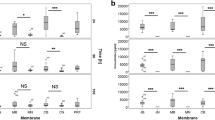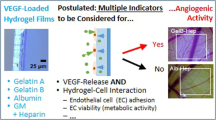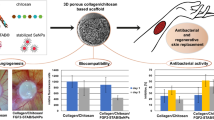Abstract
Since the survival of ingrowing cells in biomaterials for regenerative processes largely depends on the supply of nutrients and oxygen, angiogenesis plays an important role in the development of new materials for tissue engineering. In this study we investigated the possibility of enhancing the angiogenic properties of collagen matrices by covalent incorporation of the vascular endothelial growth factor (VEGF). In a previous paper we already reported the use of homo- and heterobifunctional cross-linking agents for modifying collagen matrices [1].
In the present work the angiogenic growth factor was linked to the collagen with the homobifunctional cross-linker disuccinimidyldisuccinatepolyethyleneglycol (SS-PEG-SS) in a two step procedure. The efficiency of the first reaction step–the reaction of SS-PEG-SS with VEGF—was evaluated by western blot analysis. After 10 minutes virtually all of the dimeric molecules VEGF were on average modified by conjugation with 1 cross-linking molecule. The biological activity of the conjugate was investigated by exposing endothelial cells to non-modified VEGF and to VEGF conjugated to the cross-linker. The conjugation only had a limited effect on the mitogenic activity of VEGF. We therefore applied the cross-linking reaction to the VEGF-collagen system. In a first approach the changes were evaluated by the in vitro exposure of HUVECs to non-modified matrices, to matrices in which the VEGF was simply admixed and to matrices in which the VEGF was covalently incorporated. The angiogenic properties were evaluated in vivo with the chorioallantois membrane model. In this assay the chorioallantois membrane of the chicken embryo was exposed to the same set of matrices. The covalent incorporation of VEGF has a small but significant effect both on the formation of microvessels in the chorioallantois membrane and the tissue ingrowth into the implant. The covalent incorporation of angiogenic growth factors may thus be considered as a promising approach for enhancing the angiogenic capabilities of collagen matrices. Also the cross-linking with the homobifunctional cross-linking agent has a positive effect on the angiogenic potential of the collagen matrices.
Similar content being viewed by others
Abbreviations
- CM:
-
Collagen matrix
- PBS:
-
Phosphate buffered saline
- VEGF:
-
Vascular Endothelial Growth Factor
- rhVEGF165 :
-
Recombinant human Vascular Endothelial Growth Factor (Splice variant with 165 amino acids)
- SS-PEG-SS:
-
Disuccinimidyldisuccinatepolyethyleneglycol
- PEG:
-
Polyethyleneglycol
- VEGF-PEG:
-
VEGF conjugated to the PEG-derivative
- SDS:
-
Sodiumdocedylsulfate
- PAGE:
-
Polyacrylamidegelelectrophoresis
- ELISA:
-
Enzyme Linked Immuno Sorbent Assay
- HUVEC:
-
Human Umbilical Vascular Endothelial Cell
- CAM:
-
Chorioallantoic membrane
References
J.-S. Chen, E. M. Noah, N. Pallua and G. C. M. Steffens, J. Mat. Sc.: Mat. Med. 13 (2002) 1029.
S. SOKER, M. MACHADO A. ATALA, World J Urol. 18 (2000) 10.
M. NOMI, A. ATALA, P. D. COPPI S. SOKER, Mol Aspects Med 23 (2002) 463.
M. S. PEPPER, N. FERRARA, L. ORCI R. MONTESANO, Biochem Biophys Res Commun 181 (1991) 902.
N. FERRARA, H. P. GERBER J. LECOUTER, Nat Med 9 (2003) 669.
G. E. DAVIS, K. J. BAYLESS A. MAVILA, Anat Rec 268 (2002) 252.
H. HALL, T. BAECHI J. A. HUBBELL, Microvasc Res 62 (2001) 315.
R. ZEEMAN, Ph D Thesis, University of Twente, Enschede, The Netherlands (1998).
F. DeLustro, R. A. Condell, M. A. Nguyen J. M. McPherson, J Biomed Mater Res 20 (1986) 109.
J. HARDIN-YOUNG, R. M. CARR, G. DOWNING, K. CONDON P. L. TERMIN, Biotechn. Bioeng. 49 (1996) 675.
H. BENTZ, J. A. SCHROEDER T. D. ESTRIDGE, J Biomed Mater Res 39 (1998) 539.
M. J. WISSINK, R. BEERNINK, J. S. PIEPER, A. A. POOT, G. H. ENGBERS, T. BEUGELING, W. G. VAN AKEN J. FEIJEN, Biomaterials. 22 (2001) 2291.
M. J. WISSINK, R. BEERNINK, N. M. SCHARENBORG, A. A. POOT, G. H. ENGBERS, T. BEUGELING, W. G. VAN AKEN J. FEIJEN, J Controlled Release. 67 (2000) 141.
N. CHINEN, M. TANIHARA, M. NAKAGAWA, K. SHINOZAKI, E. YAMAMOTO, Y. MIZUSHIMA, Y. SUZUKI, J Biomed Mater Res. 67 A (2003) 61.
J. S. PIEPER, T. HAFMANS, P. B. VAN WACHEM, M. J. VAN LUYN, L. A. BROUWER, J. H. VEERKAMP T. H. VAN KUPPEVELT, J Biomed Mater Res. 62 (2002) 185.
D. RIBATTI, A. VACCA, L. RONCALI F. DAMMACCO, Int J Dev Biol. 40 (1996) 1189.
G. ZWADLO-KLARWASSER, K. GöRLITZ, B. HAFEMANN, D. KLEE AND B. KLOSTERHALFEN J. Mater. Sci.; Mater. Med. 12 (2001) 195.
Author information
Authors and Affiliations
Corresponding author
Rights and permissions
About this article
Cite this article
Koch, S., Yao, C., Grieb, G. et al. Enhancing angiogenesis in collagen matrices by covalent incorporation of VEGF. J Mater Sci: Mater Med 17, 735–741 (2006). https://doi.org/10.1007/s10856-006-9684-x
Received:
Accepted:
Issue Date:
DOI: https://doi.org/10.1007/s10856-006-9684-x




